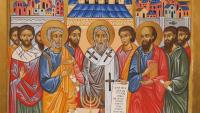
It is easy to forget that, in the early church, its members were all Jews and they still attended the temple as their place of worship. At the beginning they probably didn’t expect the gospel message to be extended to gentiles. However when Peter had the vision of the sheet of animals coming down from heaven and was directed to the house of the centurion Cornelius, he realised that the Holy Spirit had come down on this man and his household (Acts 10); therefore gentiles could become Christians too. However many people insisted that Jewish laws, such as circumcision, must continue to be observed. This led to one of the most important decisions that the church, led by Peter and James, would make. The bare minimum of Jewish practice would be required of the gentiles.
The reading from the apocalypse is very consoling, because it speaks of the “new Jerusalem coming down from God” and the names of the twelve tribes of Israel on the gates and those of the twelve apostles on the foundation stones. Thus the Old and New Covenants are linked together. These images bring seamlessly together the chosen people, whose capital was in Jerusalem, and the new Jerusalem, which has no need of a temple because the Almighty and the Lamb replace this.
In the gospel, Jesus promises the coming of the Holy Spirit, who will be the guide of the church, born on Pentecost Sunday.